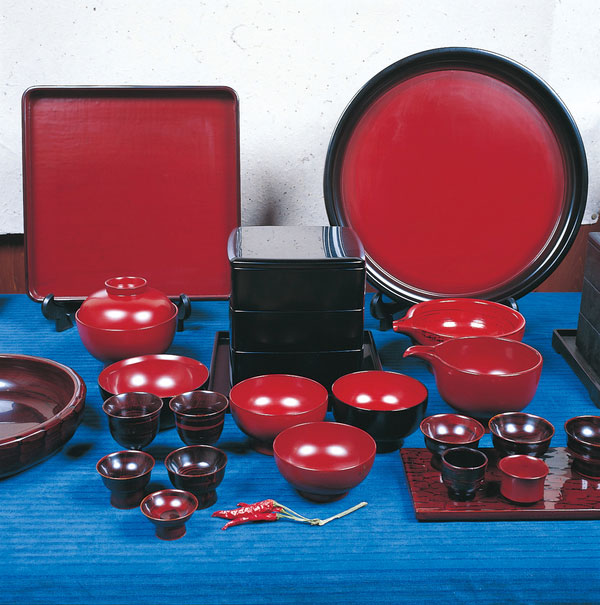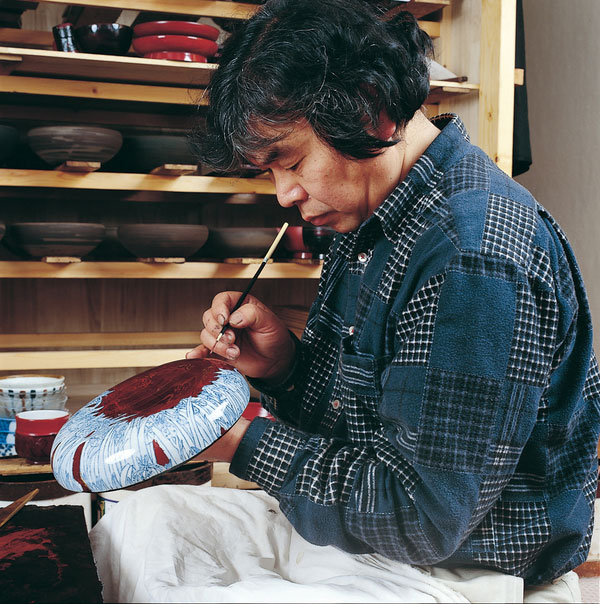 Photo:Miyagi Prefecture Tourism Division
Photo:Miyagi Prefecture Tourism Division
- Lacquerware
- Miyagi
Naruko lacquerware Naruko shikki
Artisanal technique of over 350-year history
Beautiful grain rises to the surface with every use
Description
What is Naruko lacquerware ?
Naruko lacquerware (called Naruko shikki in Japanese) is a form of lacquerware produced around the city of Osaki, Miyagi prefecture. Lacquerware is a craft coating layers of lacquer on wooden tableware and other utensils. Lacquerware is produced in various places around Japan, but developed in a unique way in the hot spring village of Naruko. Naruko lacquerware has a range of unique coating techniques. A standout example is the kijiro coating method, which makes great use of the wood grain. For lacquerware produced with this method, transparent amber lacquer is used and the beauty of the wood grain becomes more visible with continuous use. The ryumon (dragon pattern) coating method, invented in 1951, is a coating of beautifully applied marble patterning using a unique ink marbling process. Although it is a newer design, it has become a method that represents Naruko lacquerware. There are various other coating methods including the fuki urushi coating method in which transparent lacquer is coated and rubbed in, and the benitame coating method which is a beautiful shiny red lacquerware. Aside from its lovely appearance, Naruko lacquerware is strong enough to withstand use for many years as it has thick wood bases coated with lacquer multiple times.
History
Naruko lacquerware is thought to have started about three hundred fifty years ago, between the years of 1624 and 1643. Danjo Toshichika DATE, the lord of the Iwadeyama domain (present day Miyagi) sent Uhei MURATA and maki-e master Sanzo KIKUTA to Kyoto for training. After the artisans returned to Naruko, they developed lacquerware production using the techniques of Kyo lacquerware combined with their previous knowledge which resulted in Naruko lacquerware. In the latter part of the Edo period (1603-1868), there was a boom for bathing in hot springs among the middle class. The spa town of Naruko started to receive many visitors, and as a result, Naruko lacquerware was able to acquire a stable market. During the Meiji period (1868-1912), two-person lathes that had been the mainstream were replaced with single-person kick lathes which increased productivity and led to a larger range of products. Later, in the Showa period (1926-1989), Naruko lacquerware evolved in a unique way when Goichi SAWAGUCHI, a lacquering researcher from Naruko, proposed the ryumon coating method which is a dragon pattern lacquerware. Even today, there are several lacquerware artisans who continue to innovate while protecting the traditions of this craft.
General Production Process
 Photo:Miyagi Prefecture Tourism Division
Photo:Miyagi Prefecture Tourism Division
- 1. Rusting
First, wood that has been fully dried is sawed into squares of the proper sizes. Next, the pieces are cut into rough shapes, dried again, and formed into the desired shape. Round items such as bowls can be made by cutting the wood with large and small planes of various shapes while turning it on a lathe. Wood base production is done by professional woodturners instead of the lacquer craftsmen. Then, the wood base is finely smoothed, reinforced, and hardened before the first coating is applied. Adhesive containing kokuso (raw lacquer) is applied over small scratches and joints on the surface of the wood base, and the pieces are dried before being shaped by polishing. This process of applying raw lacquer to the entire wood base and drying increases the strength of the wood and the first coating becomes easy to apply. After this, rusting is done to flatten the surface of the wood and increase its strength. Small holes on the surface of the wood base are filled with the application of a rust base made by kneading together polishing powder, lacquer, and water. The craft is dried for a whole day after being coated, and the rusting is repeated multiple times.
- 2. Rust polishing
Pieces that have been rusted and dried thoroughly are polished with water. In this process called rust polishing, small protrusions on the surface of the item are planed until they become flat, and the surface is prepared so that lacquer becomes easy to apply. Then, the pieces are coated, dried, and polished repeatedly to harden the foundation of the lacquerware. The sturdiness of the foundation is directly connected to the strength of the finished product, and although not visible, it also has a deep effect on the quality and price of the lacquerware.
- 3. Intermediate coating
After the first coat has been completed, it is finally time to apply the lacquer. A special lacquer in a color that goes well with the overcoating is used for this intermediate coating process.
- 4. Intermediate polishing
The lacquer applied as intermediate coating is dried evenly while rotating in a special rotating tub. After drying, the surface is polished and flattened in the same way as the rust polishing process. By repeating the intermediate coating and polishing processes several times, the beauty and transparency of the lacquer are emphasized.
- 5. Final coating
The last step is final coating, which determines the beauty of the lacquerware. The process is similar to that of intermediate coating. However, a fine quality lacquer with a high level of purity is used for final coating, and the lacquer is applied in an exclusive room to avoid dirt and dust. Various techniques are used here too, including hana-nuri which is a coating technique that finishes up the lacquerware with a mirror-like shine without polishing the surface and roiro-nuri which is a coating using black lacquer called roiro-urushi. After lacquering is complete, any required decoration is added. While Naruko lacquerware is beautiful without additional decoration, the application of maki-e (gold/silver dust) or patterns adds gorgeous color and produces fine pieces with distinctive beauty.
See more Lacquerware
- Wajima lacquerware
- Kamakura-bori lacquerware
- Tsugaru lacquerware
- Aizu lacquerware
- Yamanaka lacquerware
- Kawatsura lacquerware
- Echizen lacquerware
- Joboji lacquerware
- Kiso lacquerware
- Hidehira lacquerware
- Kagawa lacquerware
- Ryukyu lacquerware
- Takaoka lacquerware
- Wakasa lacquerware
- Hida-shunkei lacquerware
- Ouchi lacquerware
- Kanazawa lacquerware
- Kishu lacquerware
- Kyo laquerware
- Odawara lacquerware
- Naruko lacquerware
- Niigata lacquerware
- Murakami carved lacquerware































































































































































































































































































